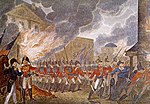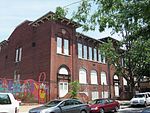Friendship Armstrong Academy
1902 establishments in Washington, D.C.African-American societyCharter schools in the District of ColumbiaCommons category link is locally definedEducational institutions established in 1902 ... and 5 more
Historically segregated African-American schools in Washington, D.C.Public elementary schools in Washington, D.C.Romanesque Revival architecture in Washington, D.C.School buildings on the National Register of Historic Places in Washington, D.C.Technical schools

Friendship Armstrong Academy is a public charter school located in the Truxton Circle neighborhood of Washington, D.C. Historically a black school, it is housed in the former Armstrong Manual Training School, also known as the Samuel Chapman Armstrong Technical High School.
Excerpt from the Wikipedia article Friendship Armstrong Academy (License: CC BY-SA 3.0, Authors, Images).Friendship Armstrong Academy
O Street Northwest, Washington
Geographical coordinates (GPS) Address Website Nearby Places Show on map
Geographical coordinates (GPS)
| Latitude | Longitude |
|---|---|
| N 38.908888888889 ° | E -77.013611111111 ° |
Address
Armstrong Public Charter School
O Street Northwest 111
20001 Washington
District of Columbia, United States
Open on Google Maps










